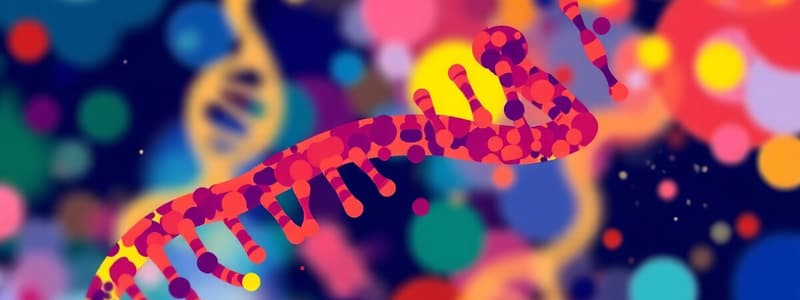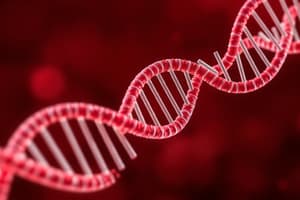Podcast
Questions and Answers
What type of DNA damage is primarily repaired by Base Excision Repair (BER)?
What type of DNA damage is primarily repaired by Base Excision Repair (BER)?
- Double strand breaks
- Single strand breaks
- Bulky crosslinks
- Base alterations (correct)
Which proteins are involved in the homologous recombination (HR) repair mechanism?
Which proteins are involved in the homologous recombination (HR) repair mechanism?
- Ku70/80 heterodimers
- BRCA1 and RAD51 (correct)
- APE endonuclease
- DNA N Glycosylases
Which repair mechanism is primarily responsible for fixing double-strand breaks?
Which repair mechanism is primarily responsible for fixing double-strand breaks?
- Non-Homologous End Joining (NHEJ) (correct)
- Nucleotide Excision Repair (NER)
- Direct repair
- Base Excision Repair (BER)
What is a key feature of Nucleotide Excision Repair (NER)?
What is a key feature of Nucleotide Excision Repair (NER)?
What recognition factors are necessary for the Mismatch Repair (MMR) mechanism?
What recognition factors are necessary for the Mismatch Repair (MMR) mechanism?
What is the primary function of DNA Polymerase during the Repair process?
What is the primary function of DNA Polymerase during the Repair process?
Which repair type is especially linked with dealing with interstrand crosslinks?
Which repair type is especially linked with dealing with interstrand crosslinks?
What are the components involved in processing double strand breaks in NHEJ?
What are the components involved in processing double strand breaks in NHEJ?
What is the primary role of methyltransferases in mRNA processing?
What is the primary role of methyltransferases in mRNA processing?
Which snRNP is primarily responsible for recognizing the 5' splice site during splicing?
Which snRNP is primarily responsible for recognizing the 5' splice site during splicing?
What defines alternative splicing in eukaryotic mRNA processing?
What defines alternative splicing in eukaryotic mRNA processing?
What is the main structural difference between snRNA and mRNA?
What is the main structural difference between snRNA and mRNA?
Which component is not involved in the formation of the spliceosome?
Which component is not involved in the formation of the spliceosome?
What is the consequence of base deamination in DNA?
What is the consequence of base deamination in DNA?
Which element is important for the regulation of gene expression in eukaryotic cells?
Which element is important for the regulation of gene expression in eukaryotic cells?
Which of the following processes involves the removal of introns from pre-mRNA?
Which of the following processes involves the removal of introns from pre-mRNA?
What is the primary role of topoisomerase II in DNA replication?
What is the primary role of topoisomerase II in DNA replication?
Which type of polymerase is responsible for synthesizing Okazaki fragments during DNA replication?
Which type of polymerase is responsible for synthesizing Okazaki fragments during DNA replication?
What consequence might arise from errors during the activity of DNA polymerases?
What consequence might arise from errors during the activity of DNA polymerases?
How does the direction of synthesis relate to the movement of DNA polymerase during replication?
How does the direction of synthesis relate to the movement of DNA polymerase during replication?
What is the primary function of flap endonuclease in DNA replication?
What is the primary function of flap endonuclease in DNA replication?
What problem does topoisomerase I address during DNA replication?
What problem does topoisomerase I address during DNA replication?
In the context of DNA repair, what is Base Excision Repair (BER) primarily responsible for?
In the context of DNA repair, what is Base Excision Repair (BER) primarily responsible for?
What is a potential consequence of mismatches during DNA replication?
What is a potential consequence of mismatches during DNA replication?
Flashcards are hidden until you start studying
Study Notes
Deamination
- Removal of an amine group from an amino acid or other organic molecule.
- Consequence: Could result in a point mutation, changing the genetic code.
Colinear vs Split
- Describes the relationship between a gene and its protein product.
- Colinear: DNA sequence directly translates into a protein sequence.
- Split: DNA sequence does not directly translate, due to introns.
Polyadenylation
- The addition of a poly(A) tail to a messenger RNA (mRNA) transcript.
- Function: Protection, transport out of the nucleus, and increased translation.
Methyltransferase
- An enzyme that adds a methyl group to a molecule.
- Function: Influences gene expression, DNA replication, and repair.
- Specific case: Methyltransferases are important for mRNA capping.
Exon
- A segment of a gene that is transcribed into mRNA and translated into protein.
Intron
- A segment of a gene that is transcribed into mRNA but not translated into protein.
- Function: Can regulate gene expression and contribute to the creation of different protein isoforms.
Lariat
- A loop-shaped structure formed during intron splicing.
- Function: Facilitates the removal of introns from pre-mRNA.
snRNA
- Small nuclear RNA.
- Function: Essential components of the spliceosome, involved in mRNA processing.
snRNP
- Small nuclear ribonucleoprotein.
- Function: A complex of snRNA and proteins that performs splicing of pre-mRNA.
Spliceosome
- A complex of snRNPs that removes introns from pre-mRNA.
Upstream Elements
- DNA sequences located before a gene.
- Function: Often regulate gene expression by interacting with transcription factors.
Downstream Elements
- DNA sequences located after a gene.
- Function: Can influence mRNA stability and translation.
Regulatory Elements
- DNA sequences that control gene expression by influencing the recruitment or accessibility of RNA polymerase.
- Function: Include promoters, enhancers, and silencers.
RNA Modification / RNA Editing
- Changes to RNA molecules after transcription.
- Function: Can modify the sequence, structure, or stability of RNA.
- Consequence: Can generate unique protein products by altering the genetic code or creating alternative splicing patterns.
RNA Processing in Prokaryotes vs Eukaryotes
- Prokaryotes: RNA processing is simpler, with fewer steps and fewer factors involved.
- Eukaryotes: RNA processing is more complex, involving capping, splicing, and polyadenylation.
Basic Structure of RNA Molecules (Emphasis on Eukaryotic mRNA)
- Structure: Single-stranded linear molecule.
- Eukaryotic mRNA:
- 5' cap (methylguanosine cap)
- 5' untranslated region (UTR)
- Protein-coding region
- 3' UTR
- poly(A) tail
The Role of mRNA Processing in Eukaryotes
- Function: Prepares mRNA for translation.
- Stages:
- Capping
- Splicing
- Polyadenylation
Importance of mRNA Capping
- Functions:
- Protects mRNA from degradation.
- Enhances translation efficiency.
- Facilitates nuclear export.
- Regulates translation initiation.
snRNA vs mRNA
- snRNA:
- Small nuclear RNA.
- Involved in splicing.
- Location: Nucleus.
- Short, non-coding sequences.
- Contains elements for transcription.
- mRNA:
- Messenger RNA.
- Encodes proteins.
- Location: Nucleus and cytoplasm.
- Long, coding sequences.
- Contains elements for transcription and translation.
Spliceosome & snRNPs
- Spliceosome: The protein/RNA complex that performs splicing.
- snRNPs: The core components of the spliceosome.
Roles of Each snRNP:
- U1: Recognizes the 5' splice site.
- U2: Recognizes the branch point and interacts with the 3' splice site.
- U4: Associates with U6 and brings it to the splicing complex.
- U5: Binds to both exons and helps to align them for splicing.
- U6: Catalyzes the splicing reaction and promotes the release of the lariat intron.
Stages of Spliceosome Assembly and Splicing
- Stage 1: Recognition of the splice sites (U1 and U2 binding).
- Stage 2: Assembly of the complete spliceosome.
- Stage 3: Intron removal.
- Stage 4: Exon ligation.
- Stage 5: Disassembly of the spliceosome.
Alternative Splicing
- Definition: A process that allows different protein isoforms to be produced from the same gene.
- Regulation: Influenced by various factors like transcription factors, splicing factors, and environmental cues.
- Role: Increases the functional diversity of biological systems.
- It can create:
- Different protein domains or lengths
- Alter protein activity
- Changes in protein localization
Studying That Suits You
Use AI to generate personalized quizzes and flashcards to suit your learning preferences.




